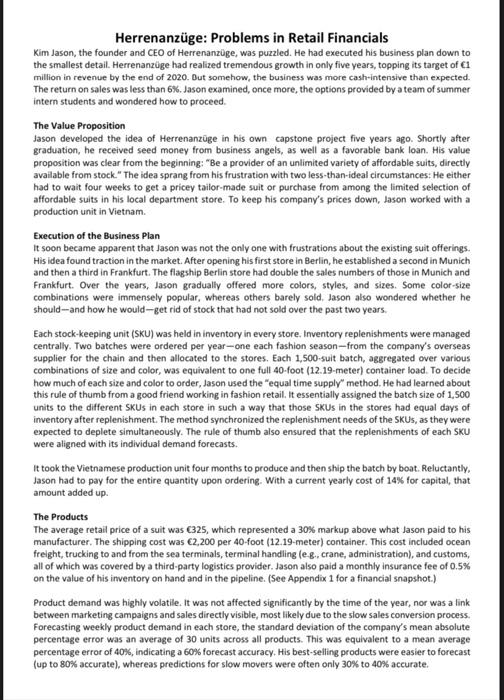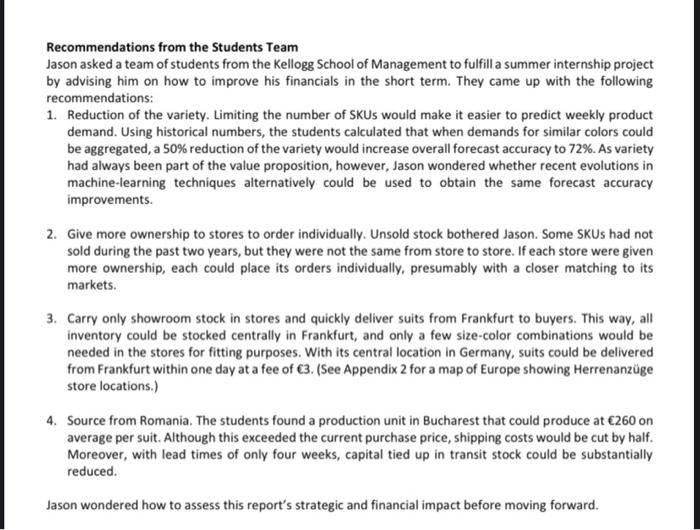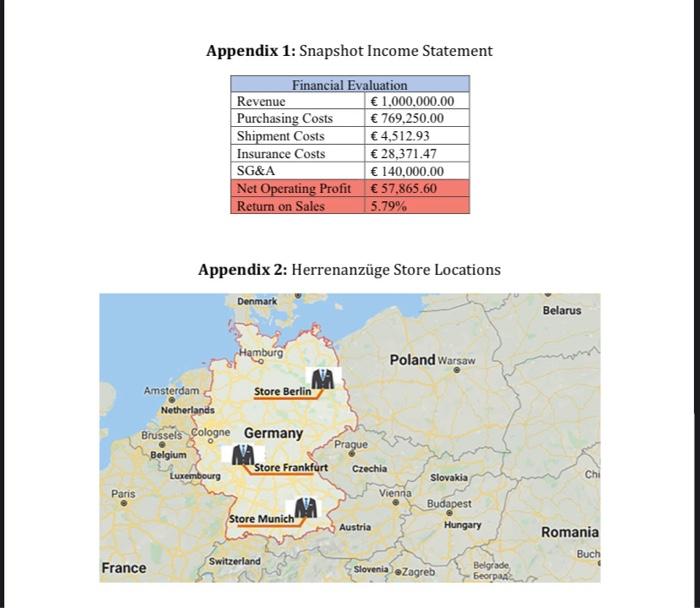1. Evaluate the recommendations made by the students team.
2. Provide a detailed strategic and financial assessment of the recommendations made by the students
team.
Herrenanzge: Problems in Retail Financials Kim Jason, the founder and CEO of Herrenanzge, was puzzled. He had executed his business plan down to the smallest detail. Herrenanzge had realized tremendous growth in only five years, topping its target of ci million in revenue by the end of 2020. But somehow, the business was more cash-intensive than expected. The return on sales was less than 6%. Jason examined, once more, the options provided by a team of summer intern students and wondered how to proceed. The Value Proposition Jason developed the idea of Herrenanzge in his own capstone project five years ago. Shortly after graduation, he received seed money from business angels, as well as a favorable bank loan. His value proposition was clear from the beginning: "Be a provider of an unlimited variety of affordable suits, directly available from stock. The idea sprang from his frustration with two less-than-ideal circumstances: He either had to wait four weeks to get a pricey tailor-made suit or purchase from among the limited selection of affordable sults in his local department store. To keep his company's prices down, Jason worked with a production unit in Vietnam Execution of the Business Plan It soon became apparent that Jason was not the only one with frustrations about the existing suit offerings. His idea found traction in the market. After opening his first store in Berlin, he established a second in Munich and then a third in Frankfurt. The flagship Berlin store had double the sales numbers of those in Munich and Frankfurt. Over the years, Jason gradually offered more colors, styles, and sizes. Some color-size combinations were immensely popular, whereas others barely sold, Jason also wondered whether he should--and how he would get rid of stock that had not sold over the past two years. Each stock-keeping unit (SKU) was held in inventory in every store. Inventory replenishments were managed centrally. Two batches were ordered per year-one each fashion season-from the company's overseas supplier for the chain and then allocated to the stores. Each 1,500-suit batch, aggregated over various combinations of size and color, was equivalent to one full 40-foot (12.19-meter) container load. To decide how much of each size and color to order, Jason used the "equal time supply" method. He had learned about this rule of thumb from a good friend working in fashion retail. It essentially assigned the batch size of 1,500 units to the different SKUs in each store in such a way that those SKUs in the stores had equal days of inventory after replenishment. The method synchronized the replenishment needs of the SKUs, as they were expected to deplete simultaneously. The rule of thumb also ensured that the replenishments of each SKU were aligned with its individual demand forecasts. It took the Vietnamese production unit four months to produce and then ship the batch by boat. Reluctantly, Jason had to pay for the entire quantity upon ordering. With a current yearly cost of 14% for capital, that amount added up The Products The average retail price of a suit was (325, which represented a 30% markup above what Jason paid to his manufacturer. The shipping cost was 2,200 per 40-foot (12.19-meter) container. This cost included ocean freight trucking to and from the sea terminals, terminal handling (eg., crane, administration), and customs, all of which was covered by a third-party logistics provider, Jason also paid a monthly insurance fee of 0.5% on the value of his inventory on hand and in the pipeline. (See Appendix 1 for a financial snapshot.) Product demand was highly volatile. It was not affected significantly by the time of the year, nor was a link between marketing campaigns and sales directly visible, most likely due to the slow sales conversion process. Forecasting weekly product demand in each store, the standard deviation of the company's mean absolute percentage error was an average of 30 units across all products. This was equivalent to a mean average percentage error of 40%, indicating a 60% forecast accuracy. His best-selling products were easier to forecast (up to 80% accurate), whereas predictions for slow movers were often only 30% to 40% accurate, Recommendations from the Students Team Jason asked a team of students from the Kellogg School of Management to fulfill a summer internship project by advising him on how to improve his financials in the short term. They came up with the following recommendations: 1. Reduction of the variety. Limiting the number of SKUs would make it easier to predict weekly product demand. Using historical numbers, the students calculated that when demands for similar colors could be aggregated, a 50% reduction of the variety would increase overall forecast accuracy to 72%. As variety had always been part of the value proposition, however, Jason wondered whether recent evolutions in machine-learning techniques alternatively could be used to obtain the same forecast accuracy improvements 2. Give more ownership to stores to order individually. Unsold stock bothered Jason. Some SKUs had not sold during the past two years, but they were not the same from store to store. If each store were given more ownership, each could place its orders individually, presumably with a closer matching to its markets. 3. Carry only showroom stock in stores and quickly deliver suits from Frankfurt to buyers. This way, all inventory could be stocked centrally in Frankfurt, and only a few size-color combinations would be needed in the stores for fitting purposes. With its central location in Germany, suits could be delivered from Frankfurt within one day at a fee of 3. (See Appendix 2 for a map of Europe showing Herrenanzge store locations.) 4. Source from Romania. The students found a production unit in Bucharest that could produce at 260 on average per suit. Although this exceeded the current purchase price, shipping costs would be cut by half. Moreover, with lead times of only four weeks, capital tied up in transit stock could be substantially reduced. Jason wondered how to assess this report's strategic and financial impact before moving forward. Appendix 1: Snapshot Income Statement Financial Evaluation Revenue 1.000.000.00 Purchasing Costs 769,250.00 Shipment Costs 4,512.93 Insurance Costs 28,371.47 SG&A 140,000.00 Net Operating Profit 57.865.60 Return on Sales 5.79% Appendix 2: Herrenanzge Store Locations Denmark Belarus Hamburg Poland Warsaw Amsterdam Store Berlin Netherlands Brussels Cologne Germany Prague Belgium M. Store Frankfurt Czechia Luxembourg Vienna Slovakia Chi Paris Budapest Store Munich Austria Hungary Romania Buch Switzerland France Slovenia Zagreb Belgrade









